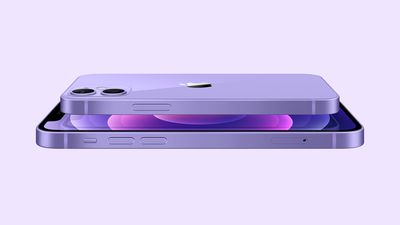iOS 17.1 Will Fix iPhone 12 Radiation Levels in France
Apple today said that the upcoming iOS 17.1 software that is set to be released later in October will lower iPhone 12 radiation levels.

France in September ordered Apple to cease iPhone 12 sales and implement a "fix" for devices that would bring them into compliance with European electromagnetic radiation standards. Apple in a support document said that it is disabling the off-body detection feature that allows for slightly higher transmit power when an iPhone is not held or in a pocket.
The detection feature is going to be disabled only in France, and Apple says that it is being turned off despite the fact that the country's Agence Française Nationale des Fréquences or ANFR regulatory group made an error when doing its radiation tests.
ANFR used a testing protocol that did not account for the iPhone's off-body detection mechanism, which Apple says has been "thoroughly tested and verified internationally to be an effective mechanism to comply with SAR requirements."
iPhone has sensors that can detect when it is sitting on a static surface, like a table, as opposed to being held in the hand or placed in a pocket. This off-body detection mechanism, which has been used in all iPhones for over a decade, allows the device to increase transmit power slightly in off-body scenarios to optimize performance.
The specific test protocol used by ANFR requires that devices meet the on-body SAR limits, even when the device is tested off-body on a static surface. This decision is not consistent with international standards, which allow for independent testing of power control mechanisms that may not be activated during standard SAR tests.
According to Apple, the iPhone 12 is safe to use "and always has been." The company's iPhones must meet international energy transmission standards for health and safety to ensure limited energy transmission when a device is in contact with the human body.
With the iOS 17.1 update, iPhone 12 models in France will no longer increase their allowed power when the off-body state is detected, so coverage in areas where cellular signal is low may cause slightly lower cellular performance in some off-body use cases, though most users are not expected to notice a change.
Popular Stories
Apple's next-generation iPhone 17 Pro and iPhone 17 Pro Max are less than three months away, and there are plenty of rumors about the devices.
Apple is expected to launch the iPhone 17, iPhone 17 Air, iPhone 17 Pro, and iPhone 17 Pro Max in September this year.
Below, we recap key changes rumored for the iPhone 17 Pro models:Aluminum frame: iPhone 17 Pro models are rumored to have an...
The long wait for an Apple Watch Ultra 3 appears to be nearly over, and it is rumored to feature both satellite connectivity and 5G support.
Apple Watch Ultra's existing Night Mode
In his latest Power On newsletter, Bloomberg's Mark Gurman said that the Apple Watch Ultra 3 is on track to launch this year with "significant" new features, including satellite connectivity, which would let you...
The upcoming iPhone 17 Pro and iPhone 17 Pro Max are rumored to have a slightly different MagSafe magnet layout compared to existing iPhone models, and a leaked photo has offered a closer look at the supposed new design.
The leaker Majin Bu today shared a photo of alleged MagSafe magnet arrays for third-party iPhone 17 Pro cases. On existing iPhone models with MagSafe, the magnets form a...
iOS 26 and iPadOS 26 add a smaller yet useful Wi-Fi feature to iPhones and iPads.
As spotted by Creative Strategies analyst Max Weinbach, sign-in details for captive Wi-Fi networks are now synced across iPhones and iPads running iOS 26 and iPadOS 26. For example, while Weinbach was staying at a Hilton hotel, his iPhone prompted him to fill in Wi-Fi details from his iPad that was already...
The iPhone 17 Pro Max will feature the biggest ever battery in an iPhone, according to the Weibo leaker known as "Instant Digital."
In a new post, the leaker listed the battery capacities of the iPhone 11 Pro Max through to the iPhone 16 Pro Max, and added that the iPhone 17 Pro Max will feature a battery capacity of 5,000mAh:
iPhone 11 Pro Max: 3,969mAh
iPhone 12 Pro Max: 3,687mAh...
Apple today seeded the second betas of upcoming iOS 18.6 and iPadOS 18.6 updates to public beta testers, with the betas coming just a day after Apple provided the betas to developers. Apple has also released a second beta of macOS Sequoia 15.6.
Testers who have signed up for beta updates through Apple's beta site can download iOS 18.6 and iPadOS 18.6 from the Settings app on a compatible...
Apple is developing a MacBook with the A18 Pro chip, according to findings in backend code uncovered by MacRumors.
Subscribe to the MacRumors YouTube channel for more videos.
Earlier today, Apple analyst Ming-Chi Kuo reported that Apple is planning to launch a low-cost MacBook powered by an iPhone chip. The machine is expected to feature a 13-inch display, the A18 Pro chip, and color options...




















